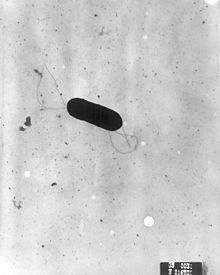User:Mr. Ibrahem/Listeriosis
| Listeriosis | |
|---|---|
 | |
| Listeria monocytogenes | |
| Specialty | Infectious disease |
| Symptoms | Diarrhea, fever[1] |
| Complications | Stillbirth, spontaneous abortion (pregnancy)[1] |
| Causes | Listeria monocytogenes[1] |
| Risk factors | Immunocompromised, pregnancy, extremes of age[1] |
| Diagnostic method | Culture of blood or spinal fluid[1] |
| Differential diagnosis | Herpes simplex virus, mononucleosis, influenza[2] |
| Prevention | Safe food handling, avoiding unpasteurized milk[1] |
| Treatment | Ampicillin, gentamicin[3] |
| Frequency | 23,000 cases per year[4] |
| Deaths | 20% (severe disease)[1] |
Listeriosis is a bacterial infection that typically results in diarrhea, fever, and muscles aches.[1] Complications may include sepsis, meningitis, or encephalitis.[1] Onset of severe disease may take up to 4 weeks after exposure.[1] During pregnancy it may cause stillbirth, spontaneous abortion, preterm birth.[1]
It is most commonly caused by Listeria monocytogenes after eating contaminated food.[1] While exposure is common, severe disease is rare.[3] Those most commonly affected include the extremes of age, immunocompromised, and pregnant.[1] Diagnosis is by culturing the bacteria from blood or cerebrospinal fluid.[1] It is not picked up by routine stool culture.[3]
Treatment of those with positive cultures is typically with the antibiotics, ampicillin and gentamicin, for two to three weeks.[3] Trimethoprim/sulfamethoxazole may be used in those who are allergic to penicillin.[2] Prevention is by safe food handling, recalling contaminated food, and avoiding unpasteurized milk and cold deli meats.[1][2] The risk of death with severe disease is about 20%.[1]
Listeriosis resulted in about 23,000 cases globally in 2010.[4] In the United States it affects about 1,600 people per year and results in about 260 deaths.[1][3] Cases may occur as part of outbreaks of disease.[1] It was first discovered to be a foodborne illness in 1981.[2] Other animals may also be affected.[5]
References[edit]
- ^ a b c d e f g h i j k l m n o p q r "Frequently Asked Questions about Listeria". Centers for Disease Control and Prevention. 1 March 2018. Archived from the original on 8 May 2017. Retrieved 24 July 2022.
- ^ a b c d Rogalla, Denver; Bomar, Paul A. (2022). "Listeria Monocytogenes". StatPearls. StatPearls Publishing. Archived from the original on 10 July 2022. Retrieved 9 July 2022.
- ^ a b c d e "Information for Health Professionals and Laboratories | Listeria | CDC". www.cdc.gov. 30 March 2021. Archived from the original on 8 July 2022. Retrieved 24 July 2022.
- ^ a b de Noordhout CM, Devleesschauwer B, Angulo FJ, Verbeke G, Haagsma J, Kirk M, Havelaar A, Speybroeck N (November 2014). "The global burden of listeriosis: a systematic review and meta-analysis". The Lancet. Infectious Diseases. 14 (11): 1073–1082. doi:10.1016/S1473-3099(14)70870-9. PMC 4369580. PMID 25241232.
- ^ Shamloo, E.; Hosseini, H.; Abdi Moghadam, Z.; Halberg Larsen, M.; Haslberger, A.; Alebouyeh, M. (2019). "Importance of Listeria monocytogenes in food safety: a review of its prevalence, detection, and antibiotic resistance". Iranian Journal of Veterinary Research. 20 (4): 241–254. ISSN 1728-1997. Archived from the original on 28 February 2022. Retrieved 11 July 2022.
